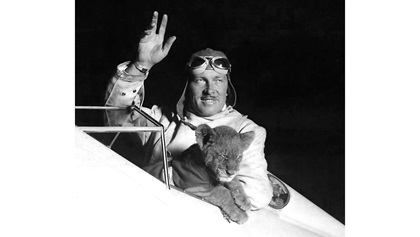Roscoe Turner Airport Corinth, Mississippi
Deep down South in a Greek-named town

 Roscoe Turner
Roscoe Turner
Roscoe Turner (1895-1970) was a flamboyant American barnstormer and air racer, widely known for his flashy flight uniform, Snidely Whiplash mustache, and traveling companion, a lion named Gilmore. Born in Corinth, Mississippi, Turner was 8 years old when the Wright brothers first flew at Kill Devil Hills. He received Army flight training, albeit in balloons, and was deployed to Europe during World War I, arriving just in time for the Armistice. He barnstormed in a Curtiss Jenny, and he formed the Roscoe Turner Flying Circus in 1919.
Turner traveled to Hollywood, where he flew in Howard Hughes’ 1930 movie, Hell’s Angels. Then, he persuaded the Gilmore Oil Company to sponsor a Lockheed airplane, which he flew on publicity flights advertising Gilmore Red Lion products. Turner adopted a lion cub who flew with him and was even fitted with his own parachute. Turner and Gilmore were popular with the airshow crowds until Gilmore grew too large and unruly to fly anymore. Gilmore lived the rest of his life on the ground and died in 1952.
Always the showman, Turner designed a unique pseudo-military flight uniform, featuring jodhpurs, riding boots, a Sam Browne belt, and military style tunic. Sporting a waxed petite handlebar mustache, he made quite a splash in aviation and Hollywood circles.
He wasn’t all show, and was one of the best air racing pilots of the time. In May 1930, Turner set the east-to-west transcontinental record, which he set again in 1932 and 1933. He won the Bendix Trophy, awarded to the winner of a race from New York to Los Angeles in 1933.
In 1934, Turner participated in the MacRobertson Trophy Air Race, a long-distance race from London to Melbourne, Australia. Flying a Boeing 247D, he and his crew covered 11,300 miles in 93 hours, finishing third. The airplane is displayed at the National Air and Space Museum.
The Thompson Trophy race, one of the National Air Races that were so popular in the 1930s, was won by Turner in 1934, 1938, and 1939. He appeared on the cover of Time magazine in 1934.
In 1939 and 1940, Turner hosted “Sky Blazers,” a radio program that dramatized aviation exploits. He also starred as himself in the 1939 Hollywood movie, Flight at Midnight, which the New York Times called a “menace.”
Turner was involved in many aviation businesses, including an Indianapolis FBO and numerous, usually short-lived, airlines. He made recommendations to the military during World War II, which were universally ignored, but his company trained 3,500 pilots. In 1952, Congress awarded Turner the Distinguished Flying Cross for “achievement while participating in aerial flight.” He was the last civilian to receive the award.
In 1961, he attended the dedication of the new Roscoe Turner Airport at Corinth, replacing the original 1936 airport, and in 1962 he was named “Character of the Year” by the International Order of Characters, a now-defunct organization of aviators.
Turner died June 23, 1970.
The airport
Roscoe Turner Airport (CRX) is 85 miles east of Memphis, Tennessee. It’s on a route between Atlanta and Memphis, or Nashville and New Orleans.
The airport has one runway, 18/36, with an asphalt surface—in good condition according to the management—that measures 6,500 feet by 100 feet at 425 feet msl. Both 100LL and Jet A is available, self-service and full-service. The FBO offers the standard amenities—coffee and vending machines, conference room, lounge, pilot supplies, showers, pilot rest rooms, Wi-Fi, and a courtesy car.
Home to history
If you’re a Civil War enthusiast, Corinth is a good location to tour important Civil War sites. It was known as the “Crossroads of the Confederacy” during the Civil War because two railroads intersected in the town, causing it to be heavily fought over. The Siege of Corinth and the Second Battle of Corinth were both fought in 1862 on the outskirts of town, including the site of the present airport.
The Crossroads Museum and Historic Corinth Depot are located near the original railroad tracks that remain busy with train traffic. After landing, visit the Corinth Civil War Interpretive Center to get oriented to the many battle sites around the town. Nineteen miles northeast of Corinth is the Shiloh National Military Park, site of the Battle of Shiloh. You can retrace the route of the Confederate Army of Mississippi as it attacked the Union Army of Tennessee (commanded by Gen. Ulysses S. Grant) from its base in Corinth.
Yummy Slugburgers
Another reason to land in Corinth is the Slugburger, the town’s signature dish. It was popularized during the Great Depression. Not made from real slugs, originally it was a hamburger patty made of ground beef with potato flour added as an extender. Today, the beef blend contains soy grits (a coarse grind of toasted soybeans) instead of potato. The burger is deep fried and dressed with mustard, pickles, and onion. Locals claim the Slugburger sold for five cents and “slug” was slang for a nickel. Today, many Corinth restaurants serve Slugburgers and if you order a burger, you’re likely to be asked, “beef or slug?”


